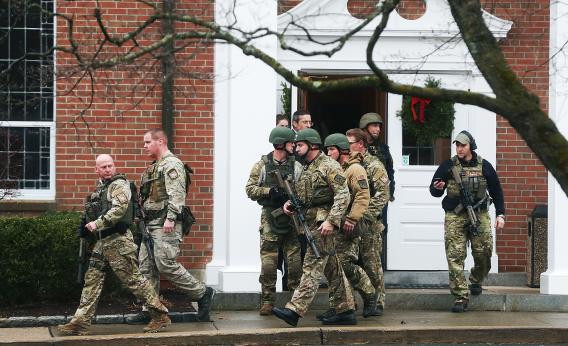Read the rest of Slate’s coverage of the Sandy Hook school shooting.
On Friday, not long after the elementary school shootings in Newtown, Conn., an Indiana man announced his plans to “kill as many people as he could” at the local school where his wife worked. When police raided his house, they found almost 50 guns. On Sunday, St. Rose of Lima Catholic Church in Newtown was evacuated during noon mass after authorities received a bomb threat. Are we facing a potential deluge of copycat crimes?
The idea that crime begets crime is one of those things that feels true. This year, we’ve seen shootings in movie theaters, malls, schools, and other locations; it’s easy to believe that these must all somehow be linked. And research on mass murder has indicated “a probable contagion effect in which the actions of some perpetrators may be triggered by reports of other events.”
But it’d be wrong to assume that we’re going to see a new wave of school shootings. The research on contagion violence and copycat crime isn’t very rigorous, and generally lacks specifics on how, exactly, one incident begets another. As Armando Simon put it in a paper published in the journal Psychological Reports, “a researcher lacks the wherewithal to establish the experimental controls within society whereby a stimulus-response relationship can be experimentally and unquestionably demonstrated.” Often, links are invented ex post facto by observers desperate to see causal connections where they may not actually exist, as in the hysteria after the release of the movie Natural Born Killers. Criminals can also cite these links as a convenient way to explain their actions (“the media made me do it”). You can spin the data however you want.
Though the public uses the term loosely and unscientifically, researchers say a true copycat crime must incorporate a key aspect of the original crime, and must be clearly influenced by media coverage of the first crime. Ray Surette, a criminologist at Central Florida University, has been studying copycat crime for decades. Surette has found that most copycats are career criminals who specialize in nonviolent burglaries and similar malfeasance. These criminals study crimes so as not to get caught—a learning-from-others’-mistakes approach. The last thing they want is to get media attention.
In 2010, after three successive violent attacks on children in China, Surette told the website LiveScience that media coverage of crimes like these can serve as a “rudder” for existing criminal energies. “You have a disturbed or already-established offender who most likely was going to do something anyway,” he said. “What the media attention does is it shapes what sort of incident it is. Someone who’s going to take a knife into an elementary school is probably disturbed enough that if he hadn’t done that, he would have done something else.” In other words, the media doesn’t cause crime so much as direct it.
In 1984, scholars S.E. Pease and C.T. Love identified four different types of copycat criminals: mode copiers, who hone their actions based on media reports; group copiers, who act in concert with each other; mentally ill or deficient copiers; and terrorists or threateners, who want to stoke fear.
Incidents like the Newtown shooting seem to bring out the threateners. After the 1999 shootings at Columbine High School in Littleton, Colo., Armando Simon found that while bomb threats against schools increased significantly, the actual number of school homicides did not. Of course, it’s possible that the homicide rate stayed flat because the police arrested the would-be killers before they had a chance to strike. It’s hard to tell—and that’s the problem.
As for the Indiana man who threatened to shoot up his wife’s school, it turns out that he was just mouthing off during a fight with his wife, and that most of the guns in his house were antiques. “If people followed through on all the threats they’ve ever made—things said in anger that they don’t really mean and regret—our population in this country would be half of what it is,” said the town’s interim police chief. “This was something he said in the heat of an argument. He hadn’t been plotting this.”
